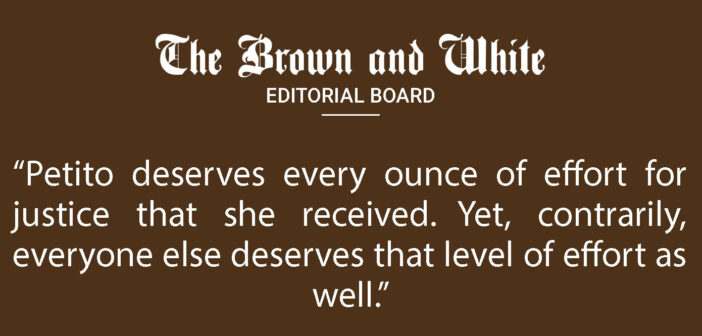Over the past two weeks, the case of Gabby Petito has swept the agenda of national media coverage.
The 22-year-old and her fiancé, Brian Laundrie, were avid travelers, exploring the country in a white van and blogging about their ventures. A few months into their cross-country trip, Petito vanished and was reported missing on Sept. 11. She was last seen near Grand Teton National Park.
Laundrie was named the primary person of interest in her disappearance after reportedly returning from Wyoming to his home in Florida – without Petito. On Sept. 21, Petito’s remains were found in Bridger-Teton National Forest. Laundrie is reportedly nowhere to be found and potentially hiding from law enforcement.
The story of Petito’s disappearance swiftly blew up across the Internet. Nearly every news outlet has covered it.
The media’s coverage initiated and drove the nationwide effort to find Petito and now, to track down Laundrie. As the news stories grew and spread, more and more people dug deeper into the disappearance, picking up clues and creating potential theories as to why and how she was murdered.
As these stories were vastly distributed, more and more people were driven to obtain justice for Petito – including those in law enforcement. Without this large-scale media coverage, her case could have easily been swept under the rug, leaving her to remain missing for months or potentially years.
That is the unfortunate reality for a multitude of missing person cases across the country. As Petito’s case blew up, 710 Indigenous people went and remain missing in Wyoming throughout the past decade, with 400 of them being women or girls.
However, we seldom see disappearance cases of minorities covered by the media. Petito deserves every ounce of effort for justice that she received. Yet, contrarily, everyone else deserves that level of effort as well.
So, why did Gabby Petito get such extensive coverage over every other missing person? Why this disappearance versus the thousands of other disappearances that happen every year?
The media loves to dive into any true crime case they can get their hands on, as they’ve learned that it garners potentially the most attention of any topic.
Publishing stories under this matter attends to the lurid curiosity of readers, who will consequently give more attention to the news cycle.
Simply put, Petito fits the narrative that the media thinks will get the most interest out of readers – what’s known as “Missing White Woman Syndrome.” Petito was white, young, pretty and somewhat of a micro-influencer.
By these means, she was what the media deemed “newsworthy.” When someone like Petito goes missing, it ensures that the story will receive a vast amount of attention.
When someone goes missing who doesn’t fit into that newsworthy narrative, the media turns their heads. By that standard, the missing person will hardly receive any coverage – becoming gone and forgotten.
Any sort of coverage is vital to the solution of such cases. Nonetheless, the media has shown time and time again that they care less about obtaining justice and more about their definition of newsworthiness that the case may carry.
Shouldn’t the end goal of any story like this be finding a solution and justice for the person involved, as well as their family and friends?
News coverage sets the course for who will get justice. When you choose to cover a case, you choose to give it attention. People across the country become more aware of the situation and its details, thus putting in their respective efforts.
This includes the efforts in the dynamic of law enforcement. It’s hard to believe that they would be so quick to find Petito’s remains without the vast coverage she got.
Hence, why the 710 missing Indigenous people in Wyoming never got the justice they all deserved. No coverage means no effort, which means no justice.
We saw what extensive news coverage gave Petito and her family— a solid answer and progress towards justice. Her family absolutely deserved all of the attention and coverage they received.
Yet, this justice could have transpired for many others missing, but never did due to not fitting into the media’s desired narrative. Their families are left without any information or answers.
Media coverage is flawed in picking and choosing whose story to elevate over the rest based on race, appearance and other defining factors. News coverage must prioritize saving lives and finding justice.
If you allow justice to be received by one, then give it to all.






Comment policy
Comments posted to The Brown and White website are reviewed by a moderator before being approved. Incendiary speech or harassing language, including comments targeted at individuals, may be deemed unacceptable and not published. Spam and other soliciting will also be declined.
The Brown and White also reserves the right to not publish entirely anonymous comments.